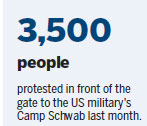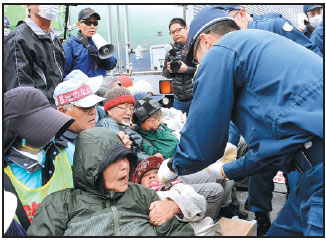Japan starts work on US Marine base
Okinawa mission has drawn staunch criticism from local residents, officials
TOKYO - The Okinawan chapter of Japan's Defense Ministry on Tuesday started constructing seawalls to surround an area in a coastal region on the island for the controversial relocation of a US military base amid uproar from local residents.
The Okinawa defense bureau launched full-scale operations to build seawalls around a site to be filled with sand and earth that will prevent sediment spreading. The land reclamation and construction are to facilitate the relocation of the US Marine Corps' Air Station Futenma.

The Futenma base is currently located in a densely populated area of Ginowan in Okinawa and will be relocated to the coastal area of Henoko in Nago City, as per the central government's plans despite resolute local opposition.
The defense bureau's new phase of construction on Tuesday follows maritime reclamation work in February involving dropping concrete blocks into the sea off the coast of Henoko from vessels equipped with large cranes.
The vessels dropped 220 blocks, each weighing 14 tons to form barriers in four areas in the sea where the seawalls will be built.
Staunch opponent
The construction has drawn staunch criticism from local residents as well as officials in Okinawa, and protests against the reclamation have been frequent.
Okinawa Governor Takeshi Onaga is a staunch opponent of the base's relocation and has been fighting to see the plan scrapped and the new base built outside of Okinawa or Japan, and has sued and been countersued by the central government.
In February, Onaga visited the United States to convey his message of resistance to President Donald Trump.
The governor has floated numerous other ways he can block the central government's plans, including not approving any changes in the construction design of the new base, which involves a V-shaped runway being built on the reclaimed land.
Tokyo, however, has maintained its stance that the relocation plan remains the only way forward in line with a pact with the US under its broader security alliance.
The protracted contentions have seen anti-US base sentiment in the prefecture rise, with regular demonstrations comprising thousands of locals calling for the Futenma base to be relocated off the island and not to the coastal Henoko region.
At the end of last month, the "prefectural people's rally calling for immediate cancellation of unlawful land reclamation work and abandonment of the plan to build a new base in Henoko" was held in front of the gate to the US military's Camp Schwab.
The demonstration attracted around 3,500 people, the organizers said.
Onaga attended the rally and stated that with all his strength he would absolutely revoke the approval to reclaim land off the shore of Henoko.
The islanders feel they have, to date, been "used" by the central government before, during and after World War II, with protests at hosting 74 percent of all US bases in Japan further intensifying following the crash-landing of an MV-22 Osprey in Nago in Okinawa in December last year.
The controversial tilt-rotor aircraft is known internationally for its checkered safety history and widely loathed by Okinawan residents.
|
Police officers remove demonstrators from a gate to the US Marine Corps' Camp Schwab in Nago, Okinawa, on Feb 7.Kyodo News Via Getty Images |
(China Daily 04/26/2017 page11)









